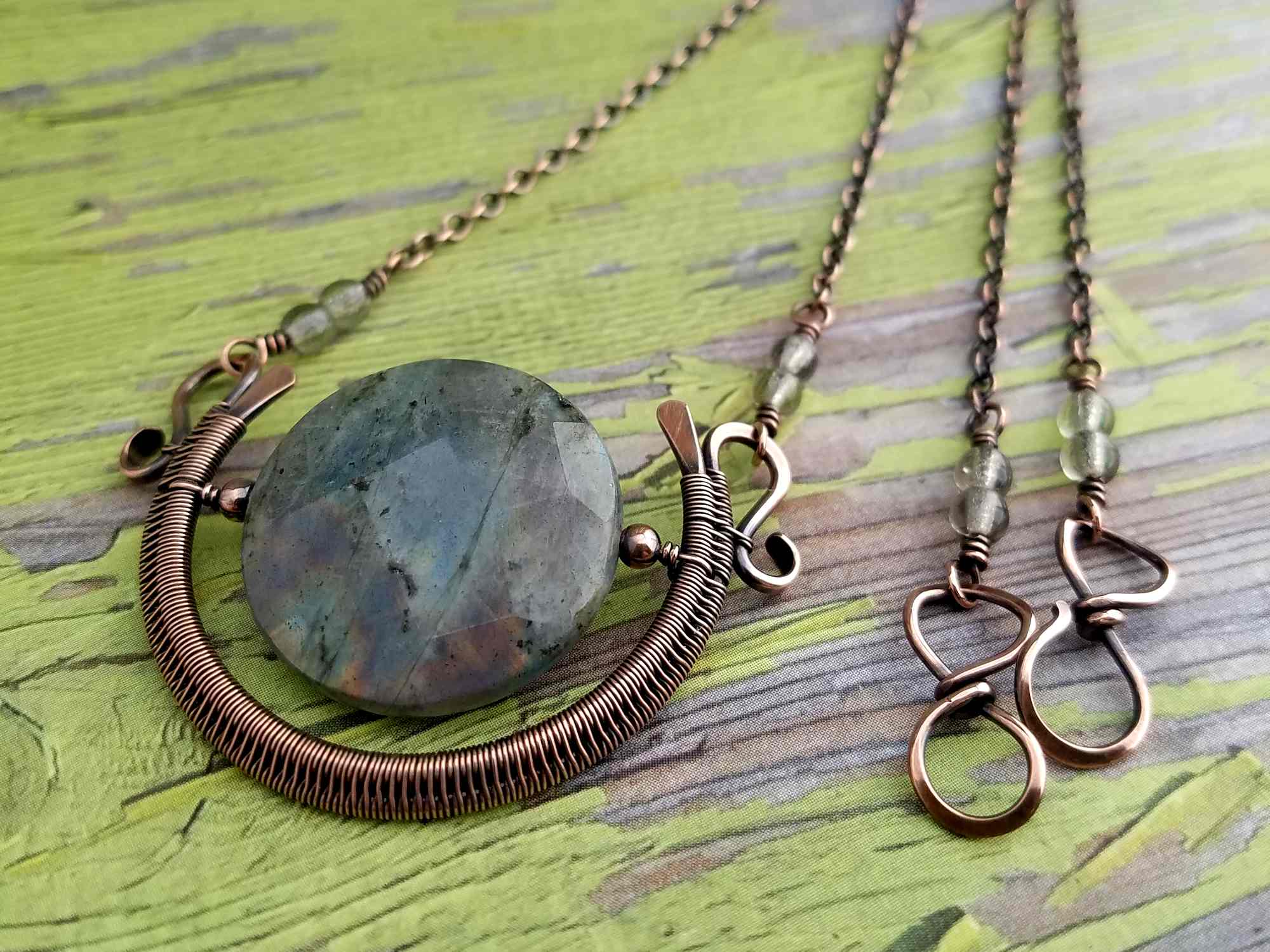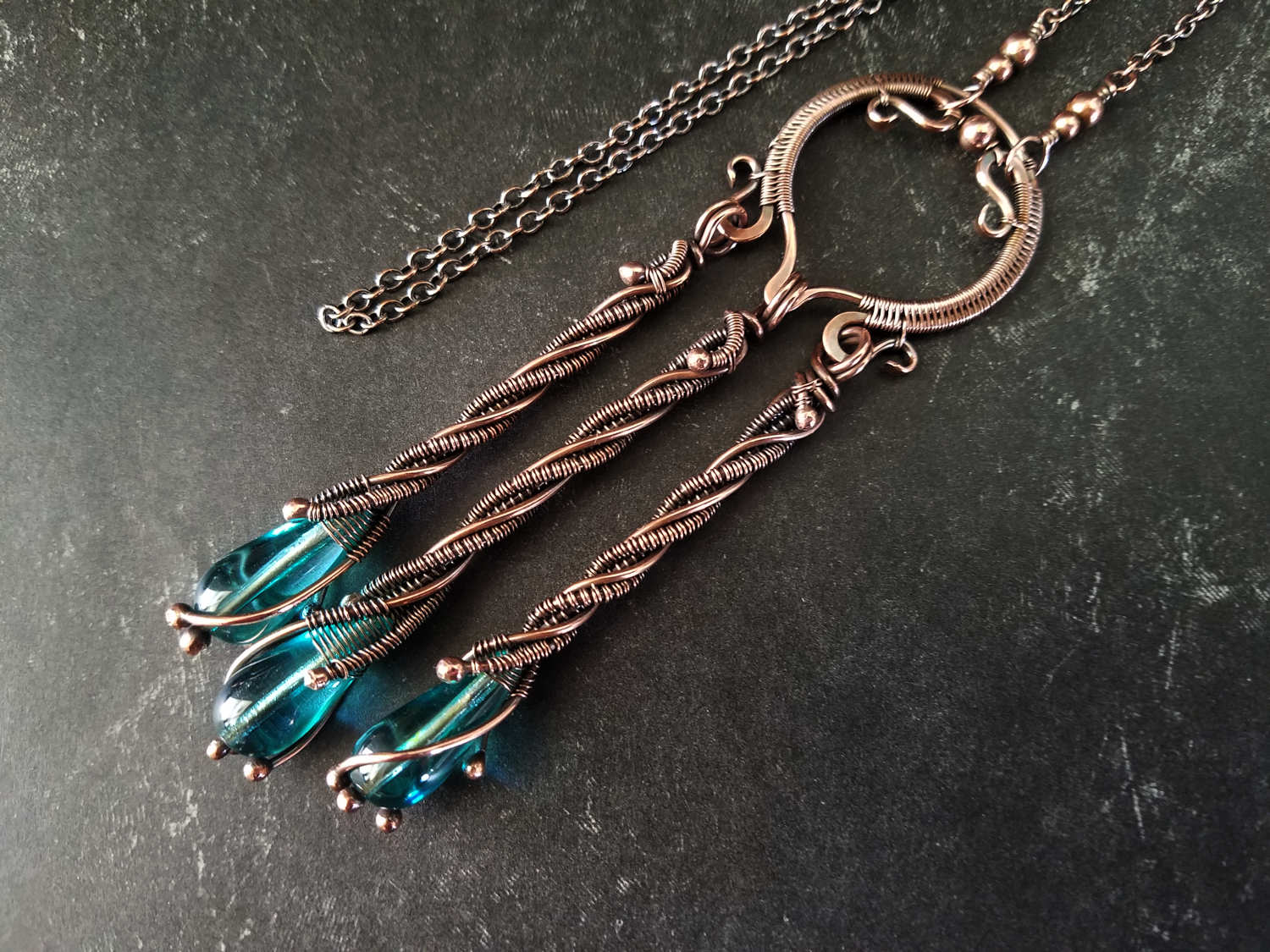Square Ear Wires: How to make matched pairs

Welcome to the fourth installment of my 5-part ear wire series. Today we’re going to make square ear wires. These wires are like those that I make for my easy wire earrings in that they have much straighter lines than a standard rounded ear hook. And, yes, they’re technically not squares. But they do have squared corners. Hence, the name.
The square ear wires are particularly suited for graphic earrings with straight angular lines. These ear wires also work well for minimalist threader-type earring designs. Try hanging a simple pearl or crystal drop on a length of delicate chain from these wires for an easy and elegant minimalist vibe.
Ear wires are a small and often overlooked detail. But I believe strongly that it’s the smallest details that will set your jewelry apart from the crowd. So pay attention to the wires that you choose for your earrings. And always choose an ear wire silhouette that compliments your earring designs.
Copyright & Disclosure
You’re welcome to make and sell products from this tutorial. These ear wires are a common design, so I claim no exclusive rights to the design itself.
When it comes to my written tutorials, however, I do reserve exclusive rights to all images and written content. You may not reproduce or redistribute any portion of the Perfectly Matched Square Ear Wires tutorial in any way, shape, or form.
This copyright applies to the printable PDF version of the Perfectly Matched Square Ear Wire tutorial as well, and it’s included therein. You may share the free version of this tutorial only by linking directly to this page.
This post may contain affiliate links. If you click on a link and then make a purchase, I may earn a small commission (at no cost to you). As an Amazon Associate I earn from qualifying purchases. To learn more, please see my full disclaimer.
Skill Level: Beginner
This is a basic wirework project that can be achieved by someone who has never worked with wire before.
Choosing the Right Wire for Your Circle Ear Wires
For best results, use half-hard or dead soft solid copper or sterling silver wire. Half-hard wire will always save you time when it comes to making ear wires, but dead soft works well, too. You’ll just have to spend a bit of extra time work hardening ear wires that you make with dead soft wire. I used dead soft wire for the square ear wires that I made while writing this tutorial.
I’m going to show you how to make the ear wires that are shown in the feature image above. And then we’ll talk about ways that you can easily modify these wires to achieve different looks.
You can use a filled wire for the square ear wires if you choose not to use a chasing hammer on your wires. I don’t recommend plated or anodized craft wire for this tutorial because those types of wire are rarely hard enough to retain their shape, and even a soft mallet can ruin the finish coat on craft wire.

Tools & Materials
- 20ga half-hard wire – 5 inches (13 cm) per pair
- Wire Cutters
- Flat Nose Pliers
- Stepped Bail-Making Pliers
- Needle File
- Nylon Mallet or Rawhide Mallet
- Chasing Hammer (optional)
- Bench Block
- Ruler
- Fine Point Permanent Marker
- Cup Burr Tool (optional)
- Sunshine® polishing cloths (optional)
*I normally use half-hard copper wire to make my ear wires, but I used dead soft copper wire while writing this tutorial. The only difference between the two tempers is that you’ll need to spend more time work hardening dead soft ear wires. That’s why I prefer to use half-hard wire for earring findings — it saves time. I’ve provided links to my preferred source (riogrande.com) for both tempers above. Choose whichever temper you like to work with best.
Finished Size
- WIDTH: About 1/4 inch (6.4 mm)
The length of your wires will vary depending on how long you choose to make the front part of your wires. The ear wires that I made while writing this tutorial, which are those pictured on the left in the feature image above, are 1-inch long (2.5 cm).
20g wire is my preference for pierced ear wires. It’s the only gauge that I use for ear wires unless someone specifically asks for a smaller or larger gauge. Commercial ear wires typically range between 18g and 22g. So 20g is a comfortable size for almost everyone with pierced ears.
How to Make Perfectly Matched Square Ear Wires
The only variation of the Square Ear Wires that I cover in these instructions is the length of the front line of the wires. I’ll show you how to make all three variations of these wires that are pictured above.
Additionally, I suggest some other variations of the Square Ear Wires that you can try in the Variations section at the end of this tutorial. You can easily customize the Square Ear Wires by simply changing the cut length of your wire and the placement of your bends.
Step 1
Straighten a length of 20ga wire by running it between your fingers or the jaws of your Nylon jaw pliers a few times. Once the wire is nice and straight, measure and cut a 5-inch length of wire.
Use your fine-point permanent marker to mark the center point of your wire.
Step 2
The key to making matched sets of ear wires is to create both wires at the same time, which is what we’re going to do today.
Use your flat nose pliers to form a sharp 90-degree bend at the center mark of your 5-inch wire. Then carefully fold the wire in half by gradually tightening that bend until the two ends of your wire are parallel.
Step 3
Tighten the fold by squeezing it closed with the tips of your flat-nose pliers, as shown.
Step 4
Check the ends of your wire to make sure they’re even. If not, trim the wire so that both ends are the same length.
Step 5
Grasp the cut tips of the wire with the 2mm step (the smallest step) of your bail-making pliers, as shown.
Step 6
Using the thumb of your free hand, firmly roll the wires all the way around the 2mm mandrel, as shown.
Adjust the position of your bail-making pliers, if necessary, to roll the wire all the way around until the cut ends touch the long length of the wire.
You just created a small simple loop for each of the two ear wires. This is the loop that will attach to your earring dangle.
Step 7
At this point, we’re going to center the small loops that we just made with the straight length of wire.
Reposition your stepped bail-making pliers so the 3mm step of your pliers are resting against the long length of your wires, as shown.
Step 8
Now, while grasping the small loops firmly with your stepped bail-making pliers, roll the straight length of wire back just slightly around the 3mm step. This will create a slight bend in the wire that will align the small simple loops with the remaining length of the wires.
Your simple loops should look something like this when finished. Make any final adjustments now to center the loops over the core wire before moving on to the next step.
Step 9
At this point, you need to decide how long you want the front line of your ear wires to fall. I made three different lengths, which are pictured here.
To make the wires of your choice, measure from the bottom of the simple loop and mark your ear wires at the length specified for each variation in the image.
I’m making the 1-inch ear wires, so I marked my wire 1 inch from the bottom of the simple loops.
Step 10
Now position your flat nose pliers on the mark you made in Step 9, as shown.
Step 11
Grasp the wires firmly with your flat nose pliers and use your thumb to press the wire into a sharp 90-degree angle against the ends of the jaws of your pliers.
Step 12
Repeat the 90-degree bend on the other side of the jaws of your flat nose pliers, as shown.
Step 13
If desired, use the 9mm step (the largest step) on your bail-making pliers to create a slight bend on the tail of your ear wires, as shown.
This step is optional. The Square Ear Wires look just as good with nice straight tails.
Step 14
Now use your wire cutters to trim off the folded end of your wires.
Make sure you position your wire cutters with the beveled side facing the fold, as shown. This gives you the cleanest cut on your finished ear wires.
Step 15
Use your needle file to remove any sharp edges on the cut ends of your circle ear wires.
If you have a cup burr, you can use that tool now to round off the ends of your ear wires, as shown.
Step 16 (Optional)
Now that your ear wires are fully formed, we need to work harden them, so they’ll retain their shape.
I like to slightly flatten certain points on my ear wires because I think it gives them a bit more dimension and more of a hand-forged look. If you prefer your wires to remain round, skip this step and go on to Step 17.
Use your chasing hammer and bench block to lightly flatten the small loops, the tail ends, and the top line of the ear wires. Don’t use too much force or the wire will spread to a width larger than 20g, which could make the wires uncomfortable to wear.
Step 17
Use the 2mm step on your bail-making pliers to tighten any gaps on your simple loops, as shown.
Step 18
Use your needle file to touch up the edges of your wire tails, if you hammered the ends with a chasing hammer. Make sure there are no sharp points that can irritate skin when putting on or taking off the ear wires.
Step 19
Once you’re completely satisfied with the look of your wires, use a nylon or rawhide hammer and your bench block to further work harden the wires.
Just tap lightly and evenly on the wires several times. Then check to see how sturdy your wires are by giving them the slightest twist. If the wire bends easily, harden it some more with your soft hammer and bench block.
Continue this process until the ear wires are noticeably stiff and springy.
That’s it. Your graphic Square Ear Wires are now complete and ready to use. You can patina them now if you like. Or just leave them bright and patina along with whatever you decide to attach them to.
I like to make ear wires in small batches of about a dozen pairs. That way I always have some perfectly matched ear wires on hand when I want to assemble earrings quickly.
Variations

There are lots of ways that you can modify the Square Ear Wires to make them uniquely your own. Here are just a few possible variations that you can create with some minor tweaks.
To make the square ear wires with front facing loops as shown in the top row of wires above, form everything exactly as instructed in the tutorial. Then grasp the loops with your flat nose pliers and twist 90-degrees to rotate the loops into the front-facing position. This allows the loop to be clearly seen from the front of the earrings.
Use your imagination to come up with some fun shapes for the loops on your own square ear wires. Then experiment to see how many ways you can integrate those shapes into graphic earring designs.
More Ear Wire Styles
Would you like to explore more ear wire styles? Be sure to check out my other ear wire tutorials.
All of these ear wires are formed using the same basic principal of shaping both wires at the same time. This allows you to create perfectly matched pairs of ear wires. In any shape. Every time.
Finishing Suggestions
I patina all of my copper and silver jewelry with Liver of Sulfur (LOS), and then I burnish the antiqued pieces with super fine steel wool (Grade #0000) in a warm bath of water and original Blue Dawn dish soap. The steel wool brings back the bright copper highlights on the high spots.
Once that’s done, I rinse the jewelry thoroughly to remove any particles of steel wool. Then I put the jewelry in a tumbler barrel filled with warm water and a generous squirt of Blue Dawn. I tumble all of my finished jewelry for a minimum of two hours.
Tumbler Tip
There’s a lot of debate about whether tumbling will work harden wire. My experience is that you can achieve some hardening, but only by tumbling for extended periods of time. So, two hours on the tumbler won’t make a noticeable difference. Twenty-four hours of tumbling does seem to noticeably increase hardness, however.
I never recommend tumbling wire jewelry with beads or gemstones for extended periods. However, there’s no risk in tumbling plain wire findings for several hours. Tumblers are designed to run for days at a time because that’s how long it takes to polish rough stones. So, if you don’t mind listening to the rustle of a tumbler for a full day, give it a try. And let me know if your ear wires came out of the tumbler noticeably harder than when they went in.
If you’re new to wirework, read this detailed tutorial that walks you through my 7-step patina process. And if you’re wondering why I recommend tumble polishing specifically, check out this post. Also, be sure to clean your stainless steel shot regularly. Because clean shot gives you the best possible final finish on your jewelry.
Discover More Behind Door 44
Thanks so much for joining me today. I hope you enjoyed creating your own Perfectly Matched Circle Ear Wires from scratch. If you’d like a printable PDF version of this tutorial, you can find it here.
Would you like more wire jewelry content?
I like to share useful wire weaving tips and tricks on my social media channels, and we have some great conversations about wire jewelry in my private Facebook Group. Also, be sure to connect with me @door44studios on Instagram, and Facebook to keep up with everything that’s happening behind Door 44. And if you haven’t already done so, be sure to subscribe to my YouTube channel where you’ll find new wire jewelry videos weekly.
Until next time, go make something beautiful!

Pin the Square Ear Wires Tutorial for Later









